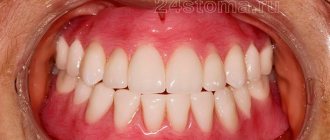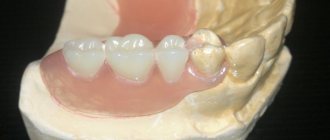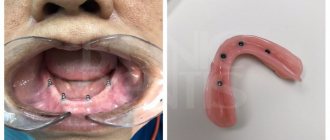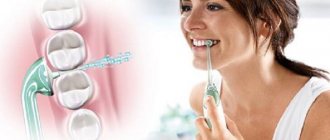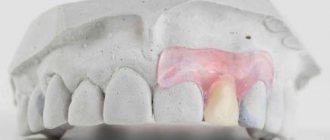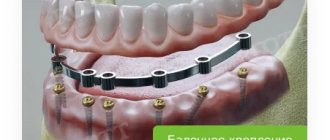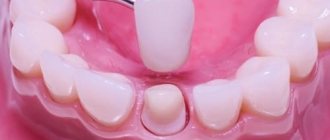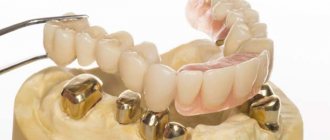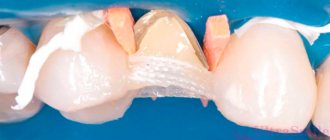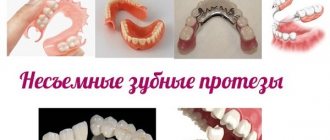Not everyone manages to keep their own teeth throughout their lives. Losing teeth is usually a matter of time. Some people lose their first molar by the age of 20, while others manage to maintain a full set of teeth until retirement. In any case, prosthetics sooner or later becomes relevant for the vast majority of patients.
Removable dentures are usually used in cases where quite a lot of teeth are lost, and the option of restoration with crowns or bridges on implants is not considered. Having a full set of teeth in your mouth is important for more than just aesthetics. Their deficiency affects the shape of the face, diction, and the ability to chew and digest food normally.
What are removable dentures?
The word “prosthesis” can be scary for some patients, especially if they are young. This word is associated with crutches, dentures and the decline of life. In fact, dentures, on the contrary, help restore the aesthetics and joy of comfortable eating. Modern technologies make it possible to make prostheses from high-quality materials. They are miniature, do not rub, do not fall out of the mouth when laughing or sneezing, and do not impair speech. In addition, artificial teeth are perfectly straight and beautiful, just like in the picture in the magazine.
The essence of the prosthesis is that artificial teeth are placed on a base made of high-strength material matching the color of the gums. The structures correctly distribute the chewing load, restore the proper functioning of the dental system and the beauty of the smile.
What is a complete removable denture on implants made of?
As a rule, such dentures are made of plastic, nylon or acrylic - modern removable dentures on implants have a fairly high level of comfort, look very natural and are made of hypoallergenic materials. The issue of aesthetics is especially important when a patient has a removable denture installed on the upper jaw on implants, since the upper front teeth are most visible when smiling. Removable dentures on implants in the lower jaw are not so noticeable.
Indications
There are a number of indications for installing removable dentures:
- Pathological abrasion of teeth.
- Inability to install single crowns or bridges due to lack of sufficient teeth, jaw characteristics or financial aspects.
- Presence of end defect.
- The inability or unwillingness of the patient to restore the dentition with crowns on implants.
- Reluctance to prepare abutment teeth to install bridges.
- Periodontal diseases (chronic periodontitis, periodontal disease).
- The need to wait for other types of prosthetics (as a temporary option).
- The desire to restore teeth quickly and without significant financial investments.
Preparing for installation
Before using removable prosthetics, as with any type of prosthetics, some preparation is required. It includes:
- Sanitation of the oral cavity. The stage includes the treatment of caries, removal of mobile, damaged and untreatable teeth. Inflammatory processes, if any, are also treated.
- Taking impressions of both jaws. In any case, there are two impressions, so that when making a prosthesis, the correct bite can be maintained, and the prosthesis does not interfere with the patient’s ability to close his jaws normally.
- Making a plaster model. Based on this model, the structure is subsequently manufactured.
- Fitting and correction stage. Fitting is an important part of the process to make wearing as comfortable as possible and avoid damage to soft tissue or supporting teeth.
Briefly about each of them
- Acrylic dentures. These are the most common and inexpensive prostheses. They are very light, do not require tooth preparation; hooks are used for fastening, covering the patient’s own teeth. The plastic from which they are made can cause allergies only in severe cases, and is used for the vast majority of cases.
- Acrylic-free dentures. From the name it is clear that acrylic is not used in these designs. They better distribute the chewing load, while the material is free of additives that can cause irritation to soft tissues. Acrylic-free dentures are durable and fit well to the gums. If there are teeth, hooks are used for fastening; if not, a system similar to a suction cup is used.
- Nylon systems. This is a traditional option for restoring several teeth, that is, small areas in a row, rather than the entire jaw. Constructions are not used for edentulous patients, since due to their softness they cannot evenly distribute the chewing load, which leads to rapid resorption of bone tissue. In terms of cost, these comfortable soft prostheses are quite expensive in comparison with those described above.
- Clasp dentures. Durable structures with a reduced contact area on the palate and gums. This is achieved due to the thin body. The base is a metal plate, which can be covered with a layer of plastic in the color of the gums. Features are: uniform load distribution, maximum preservation of bone tissue, miniature size. Fastening is carried out using hooks and locks. Due to the presence of metal, the prosthesis can occasionally cause irritation of the mucous membrane.
- Sandwich dentures. These are new generation systems that are located in the mouth without affecting the upper or lower palate. To attach them, it is sufficient for the patient to have two supporting teeth.
- Quadrotti. Nylon-based prostheses, manufactured using the latest Italian techniques. This is a variation of the sandwich system with some special features. The dentures are durable, comfortable, and do not require long getting used to.
Classification and varieties
There are many types of classification of clasps - by function, shape, material of manufacture, method of connection with the prosthetic base, location of contact, degree of crown coverage, manufacturing methods. Let's look at each classification group in more detail.
By purpose or function
- retaining clasps: used in orthodontics (occlusion correction) and orthopedics (dental prosthetics). They have only 1 function - holding the plate or removable denture on the supporting crowns. When chewing, the entire load goes to the prosthetic base and gums, which can rub, resulting in pain and stomatitis. Another method of application is fixation of rubber dam (latex film for dental treatment),
- supporting-retaining (with an occlusal pad, for example): also options are also used in orthodontic and orthopedic treatment. However, they have 2 functions - holding and support. When chewing, the load will be distributed, among other things, to the supporting teeth, their ligaments and the adjacent bone (periodontal tissue). In this case, the mucous membranes “suffer” less.
Experts note that the division into retaining and support-retaining is conditional. Because retaining hooks also transfer part of the load to the periodontium. But in this case, the distribution of pressure is incorrect, so negative consequences often appear - injuries, loosening of teeth, loss of gums.
By shape
The following types of clasps are distinguished by shape:
- flat,
- tape,
- semicircular,
- round.
Don't know what type of prosthetics to choose?
We will help in the selection, advise where to read more information and compare types of prosthetics.
Consultation with an orthopedic doctor in Moscow clinics is free! Call now or request a call
Working hours: from 9:00 to 21:00 - seven days a week
According to the method of connection with the prosthesis base
The connection can be of the following types:
- stable, i.e. rigid: the hook, through which pressure is distributed on the crown, is fixedly attached to the prosthetic base. There is almost no load on the gums and alveolar ridge,
- springy or semi-labile: a distinctive feature is the presence of a long body that is capable of springing. Here, only part of the chewing load is applied to the crown, and the rest is absorbed due to the “lever effect”,
- articular or labile: due to the presence of a hinge (or joint), almost all the pressure from the prosthesis goes not to the support, but to the gum and alveolar ridge.
At the location of contact
Based on their location or location, these elements are divided into types such as:
- dental: adjacent to the crowns, most often made of metal,
- pelota or gingival: they are wide extensions of an acrylic base, fixed only on the gums,
- dentogingival: simultaneously in contact with the gums and supporting crowns. For example, immediate dentures or “butterflies” have these – what the clasps on a denture look like is shown in the photo.
According to the degree of coverage of dental crowns
- one-armed and two-armed,
- ring-shaped (also called “changeover”),
- double,
- multi-link clasp: is a frontal overlay (it was discussed at the beginning of the article) on the lingual surface of the front teeth - most often placed on the lower ones. Externally, a multi-link one looks like either a horizontal plate with processes or several united half rings. Helps stabilize an entire group of teeth.
According to the material of manufacture
Classification according to materials of manufacture includes such types of clasps as:
- from base metals: for example, from medical steel, nickel, cobalt alloys with chromium and iron, titanium alloys,
- from noble metals: platinum, gold, palladium,
- from synthetic polymers, resins: plastic, acrylic, nylon, acetal.
By manufacturing method
- bent clasps: for production, wire is used, which is bent in accordance with individual bite parameters. Such elements are more elastic or resilient, but fit less accurately to the crowns,
- cast: the manufacturing technique of casting also involves the use of metal. Cast metal clasps are less elastic, but more accurately replicate the anatomical parameters of the crown, i.e. fit tighter
- made using cold or hot polymerization: gingival ones are made from a synthetic polymer (acrylic, nylon, etc.), usually simultaneously with the manufacture of the prosthetic base.
Which removable denture is better to install?
The choice of orthopedic design depends on the clinical picture, preferences and financial capabilities of the patient. The main condition is a correctly manufactured prosthesis, which is easy to use and receives sufficient care from the patient. It is also necessary to think about the prospects: if your plans for the future include dental implantation, then it is better to give preference to a prosthesis with a rigid base, which will more correctly distribute the load on the bone tissue, preventing its atrophy.
The average cost of installing removable dentures in Moscow is from 9,000 rubles to 60,000 rubles.
Design Features
Push-button removable dentures differ from traditional ones by the presence of additional fixing elements. Thanks to them, the structure is securely held in one position: it does not fly off or move.
The principle of attaching an orthopedic system in the mouth is simple. At the top of the implant (abutment) there is the first part of the lock - the male. The second part, the matrix, is a recess in the orthopedic structure. When putting on the prosthesis, the matrix is connected to the artificial root abutment until a characteristic click is heard.
The advantage of this method of prosthetics is that it can be implemented both after classical and after mini-implantation.
Removable structures can be installed on both the upper and lower jaws. In the first case, prosthetics are performed on at least 4 implants
, regardless of the diameter and size of the titanium roots. This is due to the soft and loose bone of the upper jaw. If there are fewer implants, it will not be possible to securely secure an orthopedic prosthesis on them.
An overlay prosthesis on 2 implants can be installed only when restoring the lower row. In this case, the diameter of titanium roots cannot be less than 4-5 mm, otherwise the stability of the entire system will suffer. If the teeth of the lower jaw are restored using mini-implants, then you will need the same number of them as for the upper jaw - four.
- On ball-shaped clamps.
The head of such products is shaped like a ball. Prostheses with ball-shaped fixation are inexpensive, but the design has one significant drawback. Gradually, the abutment heads wear out and no longer hold the system securely. In 2-3 years you will have to contact the orthopedist again. Due to high wear and tear, the products are recommended as temporary. - On equatorial abutments (locators).
Locators are shaped like a cone. Unlike spherical heads, they wear out less. This type of mounts has another advantage - they can be used to install orthopedic systems at a large angle of inclination.
